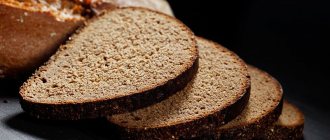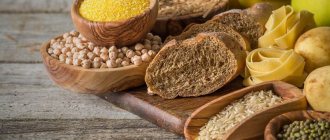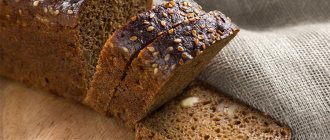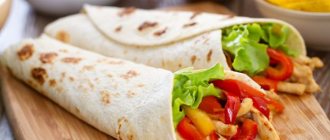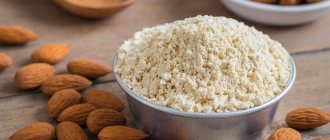Many people ask what carbohydrates are and what purpose the body needs them for. The main task of saccharides is to provide cells and tissues with the necessary energy. When consuming an excess amount of simple carbohydrate chains, the liver begins to process the remainder into glycogen, increasing the thickness of the subcutaneous fat layer. These chemical compounds make up 2.7-3% of the total body weight and are necessary for the normal functioning of internal organs. At the same time, when losing weight, you need to reduce your carbohydrate intake, and the list of foods in your diet needs to be balanced.
Carbohydrate content in bread
Bread is a product that contains a large amount of carbohydrates. They are divided into two main groups. Among them are simple and complex. The largest amount of simple carbohydrates is found in products made from wheat flour.
It is not recommended to use them during weight loss due to the glycemic index, which contributes to a rapid increase in blood sugar levels. When it enters the body in excess, carbohydrates are converted into adipose tissue.

The body receives complex carbohydrates from rye or whole grain bread. To convert them into energy, the body requires more time due to the launch of complex biochemical processes. As a result, there is a slow increase in glucose in the blood and the body spends this energy only on the work of the brain, muscles and internal organs.
Balanced diet
It is recommended that the dietary menu be compiled depending on preferences according to the following principles:
- ⅔ portions should consist of carbohydrate foods with a low glycemic index;
- less than 10% is left for protein foods;
- the other part of the dish contains fats.
It is recommended to consume foods high in carbohydrates before 15.00 so that complex saccharides have time to be digested. For breakfast you should eat cereal porridges prepared with water or milk with a low fat content. You can add fruits or herbs to first courses.
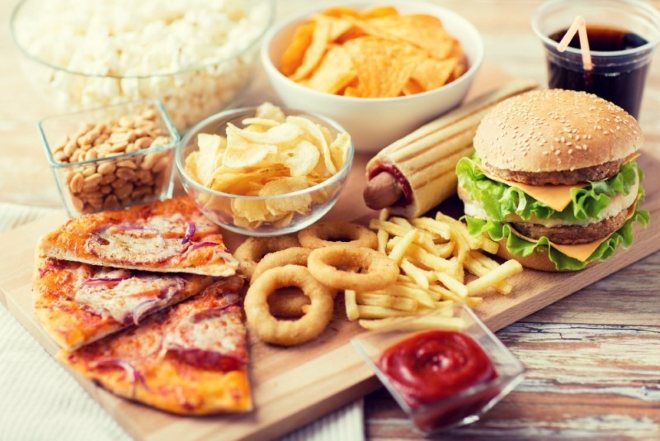
For lunch, you need to cook soups containing legumes, cut up a vegetable salad and eat a slice of whole grain bread. Herbal decoction helps improve the digestibility of food.
What happens if you completely give up bread?
With a complete and rapid refusal of carbohydrates, the development of pathological reactions from the body is possible. Among them are:
- Incessant headache. A complete refusal of bread can lead to a lack of carbohydrates in the body, from which glucose is produced, which is a source of energy. The brain is one of the organs that primarily responds to a lack of nutrients.
- Constant fatigue due to insufficient energy supply.
- Tendency to depression. Low glucose levels cause insufficient serotonin production. In the initial stages, the patient may experience depressed mood and constant anxiety, which is replaced by unmotivated aggression and depression.
- Disorders of the digestive tract. Avoiding bread leads to insufficient fiber intake. As a result, intestinal motor function decreases and the likelihood of fermentation and dysbacteriosis increases.
- Constant feeling of hunger. Lack of glucose in the body leads to a constant feeling of hunger. To reduce the severity of this symptom, it is necessary to consume a sufficient amount of complex carbohydrates.
- Hormonal imbalance.
Calorie content and nutritional value of various types of bread
Different types of bread differ not only in composition, but also in nutritional value.
Read: How to take quail eggs: their benefits at any age
Table 1. Amount of BJU and Kcal in different types of bread.
| Product | Kcal | Squirrels | Fats | Carbohydrates |
| Wheat bread | 266 | 7,7 | 2,4 | 53,4 |
| Rye bread | 224 | 4,7 | 0,7 | 49,8 |
| Grain bread | 215 | 8,5 | 1,6 | 38,58 |
| Armenian lavash | 258 | 9,2 | 1,1 | 58,2 |
We invite you to watch a video with tips on what kind of bread you should eat to avoid gaining weight:
https://www.youtube.com/watch?v=SEV7RrLZiuo
List of simple carbohydrate foods
- Sugar. This product contains quickly digestible carbohydrates and is characterized by high energy value. Sugar has no biological significance for humans, and its excessive consumption leads to caries and the development of obesity.
Product name GI Proteins (g) Fat (g) Carbohydrates (g) Calories (kcal) Brown sugar 70 — — 98,63 389,33 Rafinated sugar 75 — — 99,9 400 Beet sugar 75 — — 99,9 399 Malt sugar (maltose) 70 — — 95,3 362 - Confectionery. Cakes, eclairs, cookies, waffles and other confectionery products contain simple carbohydrates, which charge the human body with energy and also improve his mood. Systematic consumption of confectionery products provokes the development of diabetes, gastrointestinal diseases and obesity.
Product name GI Proteins (g) Fat (g) Carbohydrates (g) Calories (kcal) Halva 70 11,6 29,7 54 516,2 Cracker 70 7,4 9,4 73,1 407 Waffles 75 3,2 2,8 81,1 342,1 Sherbet 70 7,3 14,7 66,2 417 Biscuit 70 5,9 0,8 56,3 258 Donuts 85 6,4 22,8 43,1 403 Marshmallow 65 0,8 0,1 79,8 326 Jam 70 0,4 0,3 68,2 254 - Potato. Raw potatoes contain B vitamins, carotene, magnesium, calcium, iron, and folic acid. Potatoes are also rich in starch, which is poorly digestible and has a high calorie content. Heat-treated potatoes are not a dietary dish and contain “empty” calories.
Product name GI Proteins (g) Fat (g) Carbohydrates (g) Calories (kcal) Fried potato 95 2,8 9,5 23,4 192 Potato casserole 90 3 53 16,6 128 Boiled potatoes in jackets 65 2,4 0,4 11,5 82 - Rice. This product is used in dietary nutrition as it does not contain cholesterol and is a good source of carbohydrates. Nutritionists do not recommend consuming large quantities of refined white rice. Its excess in a person’s daily menu leads to the development of diseases of the circulatory system and diabetes mellitus. It is most rational to use brown or unpolished rice for cooking.
Product name GI Proteins (g) Fat (g) Carbohydrates (g) Calories (kcal) Rice porridge is sticky in water 70 1,5 0,1 17,4 78 Boiled brown rice 55 2,2 0,2 21,9 101 Boiled rice, polished 70 2,4 0,2 24,9 113 Rice pudding 85 2,95 3 22 127 Rice milk 85 1,2 0,8 10 52 Rice flour 95 5,95 1,42 77,73 366 Rice noodles 75 3,44 0,56 81,64 364 - Cornflakes. Corn flakes contain a large percentage of carbohydrates, as well as preservatives that “clog” our body with harmful compounds. Regular consumption of corn flakes in combination with sugar syrup, honey or yogurt increases a person's body weight and leads to obesity.
Product name GI Proteins (g) Fat (g) Carbohydrates (g) Calories (kcal) Cornflakes 85 9 1 81 379 Corn grits 70 8,3 1,2 71 328 Corn syrup 116 — — 77,59 286 Hominy 70 2 1 21 92 - Chocolate. This product is not only a tasty treat, but also a natural medicine. With its help, you can increase the number of blood cells, as well as prevent the development of senile dementia in old age. Nutritionists advise consuming no more than 25 g of chocolate per day.
Product name GI Proteins (g) Fat (g) Carbohydrates (g) Calories (kcal) Bitter chocolate 25 5,4 35,3 52,6 540 Milk chocolate 35 6,9 35,7 52,4 550 Chocolate eggs "Kinder Surprise" 35 8,6 35,5 52,6 564 White chocolate 38 4,2 30,4 62,2 541 Chocolate bar 75 13,51 21,39 45,84 492,7 - Fruits and berries. These products are a natural source of easily digestible simple carbohydrates. They contain vitamins and minerals that are valuable and essential for the human body.
Product name GI Proteins (g) Fat (g) Carbohydrates (g) Calories (kcal) A pineapple 65 0,4 0,2 11,5 49 Bananas 60 1,5 0,1 21 89 Dates 146 2 0,5 72,3 306 Raisin 65 1,8 — 66 271 Watermelon 72 0,7 0,2 8,8 40 Melon 60 0,6 — 9,1 39 Persimmon 55 0,5 0,3 13,5 55 Mango 55 0,5 — 13,2 67 - Natural honey. Honey contains glucose and fructose. These simple carbohydrates provide the human body with powerful energy. Honey is completely absorbed in the body. It is not recommended for use by people who are prone to allergies.
Product name GI Proteins (g) Fat (g) Carbohydrates (g) Calories (kcal) Linden honey 60 0,3 — 82,4 304 Buckwheat honey 60 0,51 — 76,77 301 Rapeseed honey 65 0,8 — 81,5 309 - Carbonated drinks. Soda contains sugar, flavorings and acids. Regular consumption of such drinks leads to obesity, diabetes, destruction of tooth enamel and the development of cancer.
Product name GI Squirrels Fats Carbohydrates Calories "Cosa-Cola" 70 — — 10,6 42 "Fanta" 70 — — 11,7 47 "Sprite" 70 — — 10,2 42
Macro and microelements in bread
High-quality bread contains the necessary macro- and microelements, as well as vitamins, which ensure the full functioning of the body.
The greatest amount of useful substances is found in products with bran or made from whole grain flour.
The daily intake of bread contains the maximum amount of selenium. This microelement is necessary for the full functioning of various biochemical processes.
When whole grains are included in the diet daily, up to 30% of manganese is replenished, which acts as an antioxidant necessary for metabolic processes in mitochondria.
In addition, with sufficient intake, metabolic processes with carbohydrates, proteins and cholesterol are restored. Bread can provide up to 5% of the daily value of such substances as calcium, phosphorus, iron, magnesium, sodium, zinc and copper.
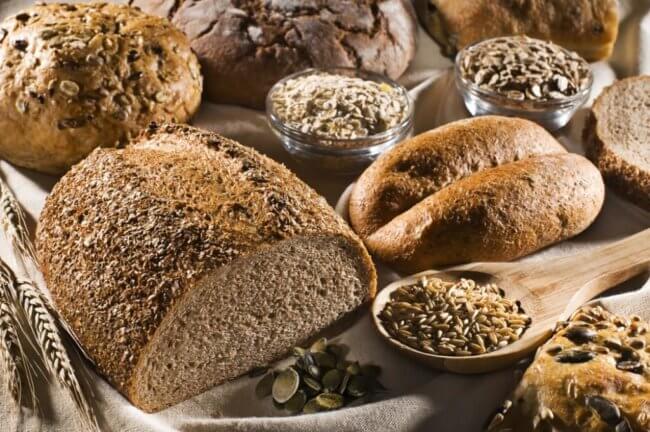
Not banned, but under suspicion
Numerous popular diets have developed in most of us a disdainful and even sharply negative attitude towards carbohydrate-containing foods. There are methods that are based on the consumption of foods low in sugars, and there are those in which they are completely prohibited because they cause a sharp increase in body weight. But is this really so and why can’t we completely give up bread, corn, legumes, and sweet fruits, if we believe the statement that they are so harmful?
In order to tell which foods are those that contain simple and complex carbohydrates, we must explain the nature of the compounds themselves, which nutritionists are afraid of.
So, we have before us organic substances that have a number of properties:
- Perform energetic and structural functions.
- They are part of complex proteins.
- They cannot be synthesized by the body - we get them exclusively from food.
Products related to essential sources of carbohydrates, a list of which we will give later, are divided into those that contain lighter and more complex compounds. We will tell you more about them below.
Vitamins in bread
In addition to beneficial microelements and fiber necessary for the normal functioning of the digestive tract, the composition contains a large amount of vitamins.
Their maximum quantity is presented in products made from rye flour and in wheat products that have undergone careful processing.
The most common vitamins include:
- B1 or thiamine. It is involved in strengthening the nervous system, which reduces the body's susceptibility to stress, as well as high mental and emotional stress. Against the background of its regular intake into the body in sufficient quantities, muscles are strengthened, including in the heart.
- B2 or riboflavin. This vitamin is involved in the full functioning of the endocrine and nervous systems, as well as erythropoiesis. With insufficient intake of riboflavin, the development of insomnia and nervous tension is noted.
- B3 or nicotinic acid. The maximum amount of nicotinic acid is contained in products made from rye flour. Against the background of its regular intake into the body, not only a sufficient amount of energy is produced, but also the condition of the skin improves. Patients have a reduced risk of developing diabetes.
- B5 or pantothenic acid. In addition to participating in all biochemical processes, pantothenic acid is involved in strengthening the immune system and improving heart function.
- Vitamin E. Thanks to its sufficient intake into the body, the condition of hair and nails, as well as the skin, improves.
Fast carbohydrates before and after training
Experts recommend that athletes and active people consume complex or slow carbohydrates before training, but simple or fast carbohydrates after.
Why are fast carbohydrates recommended to be consumed after training?
The fact is that after significant physical activity, during the recovery period of the body, time is needed to replenish muscle glycogen.
It is important to fuel your muscles with fast carbohydrates!
The faster the process of recovery of the body and muscles, the more intense the next workout can be.
Within 4 hours after finishing your workout, you need to eat at least 100 g of fast carbohydrates , and within 24 hours - 600 g.
Excellent fast carbohydrates are banana and rice.
Is it possible to eat bread when you are losing weight?
Most people who decide to lose weight first eliminate or minimize the amount of bread from their diet. Complete cessation of its use leads to a negative effect on the body.
Read: Calcium content in food: eating for health benefits
This diet product is capable of:
- Positively influence digestive function due to fiber. As a result, waste and toxins are removed.
- Stimulate the breakdown of fats, since the process of their destruction is triggered by carbohydrates. In addition, in addition to simple carbohydrates, the composition also contains complex carbohydrates. They provide a feeling of fullness for a long time.
- Replenish the amount of vegetable protein, which acts as a building material for cells, as well as vitamins and minerals.
- Produce endorphins and serotonin due to the taste of the product. It is necessary to take into account that different types of bread have different glycemic index - an indicator indicating the duration of absorption of the product. When dieting, it is important to select varieties with a low glycemic index, which are absorbed from the digestive tract for a long time and do not provoke appetite. These include Borodinsky or whole grain bread, while white bread must be completely abandoned.
In addition, to lose weight, you must follow several basic rules when consuming baked goods while losing weight. Among them are:
- Elimination of other carbohydrates when including bread in the diet. To reduce body weight, it is recommended to combine it with protein foods.
- Limit a single dose to 100 grams, in order not to exceed the permissible number of calories.
- Avoid product in the evening.
- Creation of fasting days with its complete exception.
Do fruits make you fat?
Forget this established myth about the incredible calorie content of fruits and the “up to 16” rule. It is considered normal to consume about 60 grams PURE fructose (not carbohydrates found in fruits, but fructose) daily.
BUT : In order to eat 60 grams of pure fructose from fresh fruits, you need to eat kilograms of them. Fruits contain a lot of water and fiber, and in addition, they create a feeling of fullness very quickly.

Eat, eat fruit! It is an excellent source of vitamins, fiber and minerals and is mostly low in calories.
People often ask: are fruits carbohydrates or fiber? The answer is simple: it’s both. And, by the way, fiber is also carbohydrates, just not broken down and poorly digestible.
Fructose, clear about the complex
A possible way to eat excess fructose is to consume sugary drinks, regular sugar (50% fructose), fructose syrups, sweets and sweeteners.
By the way, after a workout, the most beneficial and nutritious thing for your muscles will be a cocktail of whey protein and banana or natural grape juice. You will nourish the body with fructose, which will fill the glycogen depots depleted during the workout and feed the muscles with proteins.
Most importantly, people who maintain a calorie deficit and exercise regularly should not be afraid of fructose.
Banana: friend or foe?
You will gain weight even on buckwheat if you eat kilos of it. People get fat from a general excess of calories, not from fruits. Therefore, fruits and any other foods can be eaten at any time of the day, as long as you do not go beyond your caloric intake limits.
Any restrictions on the timing of carbohydrate intake are nothing more than an attempt to force a person to eat less during the day if he does not count calories.
No single food or nutrient is the sole cause of excess weight. People gain weight when they regularly eat more calories than they need.
RESULT : Large amounts of PURE glucose, which cannot be obtained from fruits, are harmful.
Bread for children, which is better, in what quantities
The preparation of a daily diet for children must comply with standards that will ensure full physical and neuropsychic development. The supply of sufficient energy, various vitamins and microelements prevents developmental delays and the formation of vitamin deficiency.
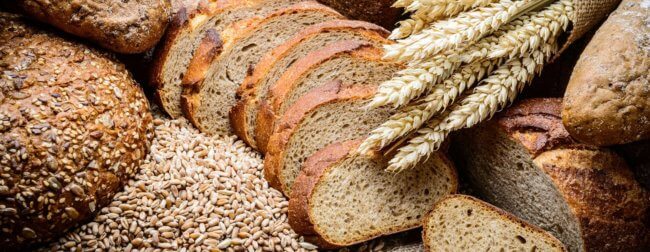
Bread is one of the products that should be present in the diet every day. They are included in the child’s menu from one year old. It is recommended to start complementary feeding with white bread, as it is easily absorbed and digested.
By the age of one and a half years, rye bread is also added to the menu. It is one of the healthier products compared to wheat, as it contains a sufficient amount of B vitamins, dietary fiber, and plant proteins.
The daily norm for children under one and a half years old should not exceed 20 grams of rye bread and 40 grams of wheat. From one and a half to three years, 30 and 60 grams. If baked goods, such as cookies or rolls, are added to the child’s menu, the amount of wheat bread is reduced.
Bread for the elderly
For elderly people, it is necessary to carefully consider the preparation of the daily menu. In many ways, nutritional habits change due to age against the background of acquired diseases and changes in the functional activity of the digestive tract.
Read: How to eat carrots to get maximum benefits
First of all, it is necessary to take into account the presence of acquired pathologies. Among them, the most common are type 2 diabetes mellitus, colitis and gastroduodenitis of various origins.
Diabetes requires daily menu control, and white bread and various baked goods have a high calorie content due to simple carbohydrates.
Changes in the functional activity of the digestive tract are associated with a decrease in motor function. In addition, as patients age, they lead a sedentary lifestyle, which increases the risk of developing constipation.
To prevent abdominal pain and accumulation of feces in the intestines, preference should be given to products with coarse fiber. This can be whole grain rye bread in small quantities.

Potato
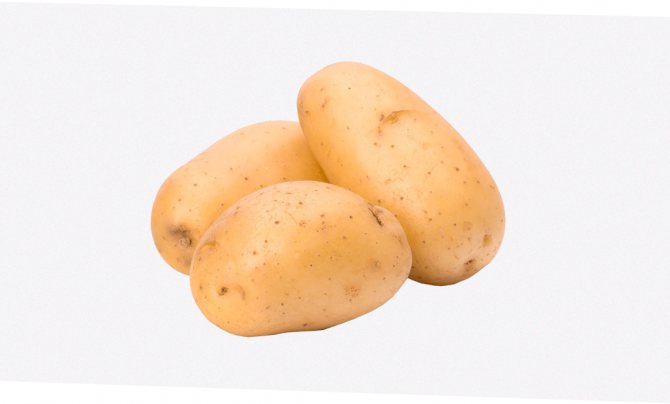
Potatoes get a bad rap, even though they contain vitamin C, potassium and even small amounts of protein. If you eat it directly with the skin, you can also get the necessary amount of fiber, which speeds up digestion.
The method of preparation is important: if you bake or fry the potatoes without adding cheese or mayonnaise sauces, then they will be healthy for you. If you use deep frying, sunflower oil and other additives, then all the benefits of potatoes, with the exception of their bright taste, disappear.
Harm from bread
Despite the benefits that bread has when entering the body, there are also negative factors associated with its consumption. Its harm depends on the type of product that is introduced into the human diet.
When eating white bread, the following are distinguished:
- Increased blood viscosity.
- Disturbance of intestinal microflora. Excessive intake of products made from wheat flour enhances the fermentation process and slows down peristalsis, which provokes constipation, discomfort and pain in the abdominal area.
- Metabolic disorders, as well as an increased risk of obesity. White bread is considered a high-calorie product with a low content of vitamins and microelements. This is due to the high degree of processing of wheat grains and the loss of useful substances with waste particles.
When eating rye bread, the following are distinguished:
- Digestive disorders associated with the presence of coarse fibers.
- Irritant effect of the product on the gastric mucosa. If consumed regularly in large quantities, it can cause heartburn, stomach pain and belching due to increased acidity.
- Reduced absorption of nutrients due to coarse fiber contained in the composition.
- Digestive disorders due to gluten intolerance.
Simple or fast
This group includes compounds that contain 1-2 molecules. These substances are divided into 2 types.
Monosaccharides
During hydrolysis, their structure does not undergo changes - they do not break down into simpler components. Distinctive features: sweetness, rapid dissolution in water.
This group includes:
- Glucose is the most common light carbohydrate, which is rich in berries and fruits. The second name for this compound is dextrose. Its remains are building material for more complex substances (such as glycogen and starch). There is also glucose in sucrose. This is a valuable source of energy, without which the heart, brain and many tissues would be left without nutrition. Its absorption is impossible without the participation of insulin, a hormone that regulates carbohydrate metabolism. The consequence of its insufficient production is the development of diabetes.
- Galactose is also a simple sugar and is found in dairy products and some energy drinks. The substance in question is formed as a result of the hydrolysis of lactose, and in the liver it is converted into the already described glucose.
- Fructose is another monosaccharide. It is not involved in replenishing glycogen reserves, is absorbed more slowly, and acts as one of the main ingredients in sports drinks and nutrition. This is the sweetest of sugars and is best obtained from fruits and berries. An excess of this substance can lead to problems with the heart, liver, and the development of metabolic syndrome - metabolic disorders.
Disaccharides
These polyfunctional compounds consist of 2 molecules of simple substances, which were mentioned above. The most famous of them:
- Lactose – found in milk and dairy products, plays an important role in the development of a child and is the main component of baby food. Cleavage occurs in the gastrointestinal tract under the influence of the enzyme lactase. In adults, lactase activity is lower than in children. This leads to the formation of intolerance to whole milk.
- Maltose – This variety is rarely seen in its free form. Most often it is presented in grains of barley, rye, products made from malt, and molasses. Also present in tomatoes and some plants.
- Sucrose is a combination of glucose and fructose, one of the most effective immunosuppressants. This substance does not exist in nature. It was synthesized artificially - in man-made beets and sugar cane.
Recommendations for bread consumption
Despite the benefits of this product, it is necessary to take into account its negative effects on the body. Therefore, following basic food intake recommendations is important for every person. Among them are:
- Use the daily amount of the product, without exceeding the amount.
- Preference is to include whole grain or rye flour products in the diet.
- Complete exclusion of baked goods if the body is intolerant to them.
We recommend a video about the benefits and harms of bread:
Adding bread to your menu every day will help avoid the development of vitamin deficiency and also improve the functioning of the digestive system. An excess of wheat flour products is not recommended for people at any age, therefore, despite the variety of products and their taste, it is important to limit their intake.
Read along with this article:
- Carbohydrates: which foods contain more of them, their importance for the body
- Foods containing large amounts of protein: benefits for the body
- Low-carbohydrate diet - a list of foods that allow you to quickly...
- What effect does coarse fiber have on the body, in what…
- The ABC of taste: calorie content of smoked capelin
- What cereals can you eat if you have diabetes: nutrition for...
- Phosphorus in food - table of standard values and...
- The ABCs of healthy eating: which foods are rich in magnesium
- Beneficial properties of glucose: what is dextrose for, and what...
Complex and slow
These polyfunctional compounds have several chains of monosaccharide molecules in their structure. These include:
- Starch
- there is a lot of it in whole grain bread, various cereals, rice, potatoes, and legumes. There are 4 types of this complex carbohydrate found in nature. The first can be found in beans, peas, lentils, and chickpeas. It is distinguished by its resistance to digestion and its connection with fiber. The second type is found in potatoes and corn that have not undergone heat treatment, and in bananas and greens. The third is found in the same potatoes, boiled or fried, and in rice. The fourth is the brainchild of chemical processing. It is not found in natural food. Particularly useful is resistant starch, which is a breeding ground for bacteria that help our intestines work properly and smoothly. The main task of a modern person who wants to improve their health is to learn to distinguish a resistant substance from a regular one, which is rich in food stuffed with refined carbohydrates.
- Fiber
is valuable coarse fiber that is found in fruits, vegetables, cereals, nuts, and beans. They carefully cleanse the intestines, remove waste and toxins, help reduce cholesterol levels in the blood, and also slow down the absorption of glucose. We know that eating fiber in your diet is the key to keeping you full for longer. And if we are full, we will not need high-calorie and sugary snacks that lead to weight gain.
- Glycogen
is glucose molecules assembled into a single chain, an excess of monosaccharide that enters the blood. They are deposited in the liver and muscle tissue. If you play sports, you know that a lack of glycogen leads to feelings of fatigue, weakness, and physical exhaustion. That is why, before a long workout, you need to eat something light, but filling and healthy - for example, a medium-ripe banana, a salad of berries and fruits.
Since realizing the importance of multifunctional compounds, we have been concerned with the question of which foods contain carbohydrates. Increased interest is associated with conversations about the dangers of mono- and disaccharides. Are they really that dangerous and why are they called the enemies of a slim figure? Let's look into this further.
